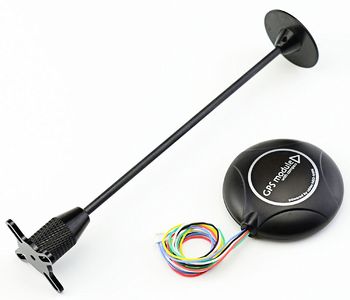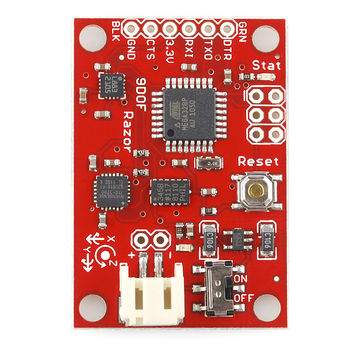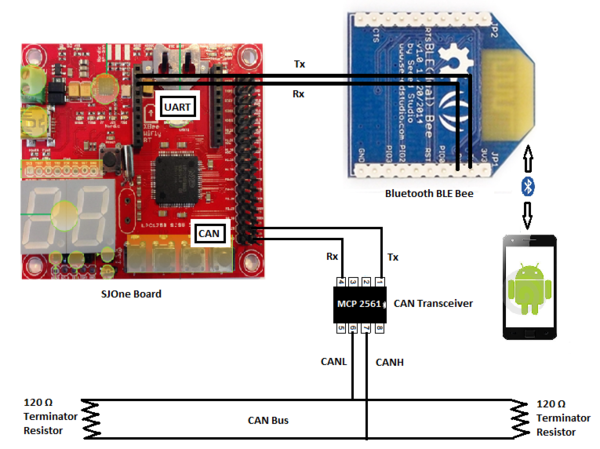This section should be a couple lines to describe what your project does.
Show list of your objectives. This section includes the high level details of your project. You can write about the various sensors or peripherals you used to get your project completed.
| Week#
|
Start Date
|
End Date
|
Task
|
Status
|
| 1
|
09/13/2016
|
09/20/2016
|
Investigate on what type of sensors are needed and the model of sensors to use and order them.
|
Completed
|
| 2
|
09/21/2016
|
09/27/2016
|
Interface one sonic sensor and test with different environment conditions.
|
Completed
|
| 3
|
09/28/2016
|
10/11/2016
|
Interface all front sensors. Stress test the sensors & log the values on SD card. Design a filter based on the log so that reliable readings are sent to the master.
|
Completed
|
| 4
|
10/12/2016
|
10/24/2016
|
Integrate sensors with motors and test the sensor values while car is on the move.
|
In Process
|
| 5
|
10/12/2016
|
10/24/2016
|
Mount the sensors & sensor controller on the car and integrate it with rest of the controllers.
|
Not Started
|
| 6
|
10/24/2016
|
11/07/2016
|
Tune & optimize the sensor filter logic and the sensor mount as required.
|
Not Started
|
Design & Implementation
The design section can go over your hardware and software design. Organize this section using sub-sections that go over your design and implementation.
Hardware Design
Discuss your hardware design here. Show detailed schematics, and the interface here.
Hardware Interface
In this section, you can describe how your hardware communicates, such as which BUSes used. You can discuss your driver implementation here, such that the Software Design section is isolated to talk about high level workings rather than inner working of your project.
Software Design
Show your software design. For example, if you are designing an MP3 Player, show the tasks that you are using, and what they are doing at a high level. Do not show the details of the code. For example, do not show exact code, but you may show psuedocode and fragments of code. Keep in mind that you are showing DESIGN of your software, not the inner workings of it.
Implementation
This section includes implementation, but again, not the details, just the high level. For example, you can list the steps it takes to communicate over a sensor, or the steps needed to write a page of memory onto SPI Flash. You can include sub-sections for each of your component implementation.
Testing & Technical Challenges
Describe the challenges of your project. What advise would you give yourself or someone else if your project can be started from scratch again?
Make a smooth transition to testing section and described what it took to test your project.
Motor & I/O Controller
Schedule
| Week#
|
Start Date
|
End Date
|
Task
|
Status
|
| 1
|
09/13/2016
|
09/20/2016
|
Order Components and work distribution
|
Completed
|
Design & Implementation
The design section can go over your hardware and software design. Organize this section using sub-sections that go over your design and implementation.
Hardware Design
Discuss your hardware design here. Show detailed schematics, and the interface here.
Hardware Interface
In this section, you can describe how your hardware communicates, such as which BUSes used. You can discuss your driver implementation here, such that the Software Design section is isolated to talk about high level workings rather than inner working of your project.
Software Design
Show your software design. For example, if you are designing an MP3 Player, show the tasks that you are using, and what they are doing at a high level. Do not show the details of the code. For example, do not show exact code, but you may show psuedocode and fragments of code. Keep in mind that you are showing DESIGN of your software, not the inner workings of it.
Implementation
This section includes implementation, but again, not the details, just the high level. For example, you can list the steps it takes to communicate over a sensor, or the steps needed to write a page of memory onto SPI Flash. You can include sub-sections for each of your component implementation.
Testing & Technical Challenges
Describe the challenges of your project. What advise would you give yourself or someone else if your project can be started from scratch again?
Make a smooth transition to testing section and described what it took to test your project.
Geographical Controller
Design & Implementation
The design section can go over your hardware and software design. Organize this section using sub-sections that go over your design and implementation.
Hardware Design
Discuss your hardware design here. Show detailed schematics, and the interface here.
Hardware Interface
In this section, you can describe how your hardware communicates, such as which BUSes used. You can discuss your driver implementation here, such that the Software Design section is isolated to talk about high level workings rather than inner working of your project.

|
GPS Module: Readytosky Ublox NEO-M8N
This GPS module uses UART serial communication interface. The refresh rate ranges from 1Hz up to 10Hz with a default baud rate of 9600bps. This module is an updated version to the Ublox NEO-M7N which brings improved accuracy of up to 0.9 meters using its build in antenna.
Specifications:
- Power Supply:DC Voltage 2.8V~6.0V
- Power Consumption: 50mA@5V
- Support for GPS,GLONASS,Galileo,BeiDou,QZSS and SBAS
- 72 Searching Channel
- Receiving Sensitivity:Trace -167dBm, Capture-148dBm
- Positioning Time:Cold Start:avg26s, Warm Start:avg25s, Hot Start:avg3s
- positioning accuracy:2m At Open Wind
- Output Frequency:1Hz-10Hz,Default 1Hz
- Speed accuracy:0.1 m/s (Without Aid)
- Acceleration accuracy:0.1 m/s (Without Aid)
- Dynamic Characteristics:Max Height:18000m, Max Speed:515m/s, Max Acceleration:4G
- UART Interface:UART Port:TXDA and RXDA
- Support Rate:4800bps to 115200bps,Default 9600dps
- Working Temperature:-40℃-+85℃
- Storage Temperature:-40℃-+85℃
- Diameter:45mm
- Height:6mm
- Weight:10g
- 6pins 1.25mm port
GPS Connector Definition:
- GND,
- TX,data output
- RX,data intput
- VCC,2.8V-6V
|

|
Razor IMU - 9 Degrees of Freedom
The 9DOF Razor IMU incorporates three sensors - an ITG-3200 (MEMS triple-axis gyro), ADXL345 (triple-axis accelerometer), and HMC5883L (triple-axis magnetometer) - to give you nine degrees of inertial measurement. The outputs of all sensors are processed by an on-board ATmega328 and output over a serial interface.
|
Software Design
Show your software design. For example, if you are designing an MP3 Player, show the tasks that you are using, and what they are doing at a high level. Do not show the details of the code. For example, do not show exact code, but you may show psuedocode and fragments of code. Keep in mind that you are showing DESIGN of your software, not the inner workings of it.
Implementation
This section includes implementation, but again, not the details, just the high level. For example, you can list the steps it takes to communicate over a sensor, or the steps needed to write a page of memory onto SPI Flash. You can include sub-sections for each of your component implementation.
Testing & Technical Challenges
Describe the challenges of your project. What advise would you give yourself or someone else if your project can be started from scratch again?
Make a smooth transition to testing section and described what it took to test your project.
Communication Bridge Controller
Design & Implementation
The design section can go over your hardware and software design. Organize this section using sub-sections that go over your design and implementation.
Hardware Design
Here is the hardware block diagram of Communication Bridge Controller.

Hardware block diagram for Communication Bridge Module
Here is the hardware block diagram of Communication Bridge Controller.
Here is the hardware block diagram of Communication Bridge Controller.
Here is the hardware block diagram of Communication Bridge Controller.
Hardware Interface
In this section, you can describe how your hardware communicates, such as which BUSes used. You can discuss your driver implementation here, such that the Software Design section is isolated to talk about high level workings rather than inner working of your project.
Software Design
Show your software design. For example, if you are designing an MP3 Player, show the tasks that you are using, and what they are doing at a high level. Do not show the details of the code. For example, do not show exact code, but you may show psuedocode and fragments of code. Keep in mind that you are showing DESIGN of your software, not the inner workings of it.
Implementation
This section includes implementation, but again, not the details, just the high level. For example, you can list the steps it takes to communicate over a sensor, or the steps needed to write a page of memory onto SPI Flash. You can include sub-sections for each of your component implementation.
Testing & Technical Challenges
Describe the challenges of your project. What advise would you give yourself or someone else if your project can be started from scratch again?
Make a smooth transition to testing section and described what it took to test your project.
Central Controller
Design & Implementation
The design section can go over your hardware and software design. Organize this section using sub-sections that go over your design and implementation.
Hardware Design
Discuss your hardware design here. Show detailed schematics, and the interface here.
Hardware Interface
In this section, you can describe how your hardware communicates, such as which BUSes used. You can discuss your driver implementation here, such that the Software Design section is isolated to talk about high level workings rather than inner working of your project.
Software Design
Show your software design. For example, if you are designing an MP3 Player, show the tasks that you are using, and what they are doing at a high level. Do not show the details of the code. For example, do not show exact code, but you may show psuedocode and fragments of code. Keep in mind that you are showing DESIGN of your software, not the inner workings of it.
Implementation
This section includes implementation, but again, not the details, just the high level. For example, you can list the steps it takes to communicate over a sensor, or the steps needed to write a page of memory onto SPI Flash. You can include sub-sections for each of your component implementation.
Testing & Technical Challenges
Describe the challenges of your project. What advise would you give yourself or someone else if your project can be started from scratch again?
Make a smooth transition to testing section and described what it took to test your project.
My Issue #1
Discuss the issue and resolution.
Conclusion
Conclude your project here. You can recap your testing and problems. You should address the "so what" part here to indicate what you ultimately learnt from this project. How has this project increased your knowledge?
Project Video
Upload a video of your project and post the link here.
Project Source Code
References
Acknowledgement
Any acknowledgement that you may wish to provide can be included here.
References Used
List any references used in project.
Appendix
You can list the references you used.


